Tactical games, RPGs, games with lots of choices that can influence the game… These are all things that I enjoy. They’re also all parts of the Fallen Legion games, and I got a chance to play Fallen Legion: Flames of Rebellion. Fallen Legion is made up of two stand-alone games, but they aren’t true sequels, they’re two sides of a single story. Fallen Legion: Sins of an Empire follows Princess Cecille and a magical grimoire whereas Fallen Legion: Flames of Rebellion (the game being reviewed here) follows Legatus Laendur. They consider each other enemies on their paths to take control of the kingdom of Lemuria, but they’re far from the only things standing in each other’s way.
I haven’t played Fallen Legion: Sins of an Empire, so I can’t speak on the exact differences, how many enemies and graphics are reused, how similarly the titles play or how much the games cross over storywise, but I can certainly talk about what a mixed bag Fallen Legion: Flames of Rebellion is. There isn’t a single aspect of the game that felt great or terrible, and while I hate myself a little for giving up on the game when I did, it was also a relief to be done with it.
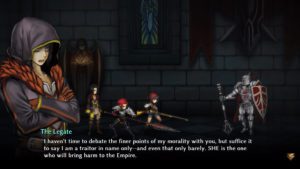
The story is fairly complex, and honestly even after playing it for a couple days I couldn’t tell you most of the details. You play as Legatus Laendur, a tactician who is convinced to work on taking over the kingdom. At first he fears it would be considered treason, but is convinced that Princess Cecille has been corrupted by an evil, mighty, talking grimoire. However, there are loads of issues aside from marching on the capital – you don’t know which Princes you can trust, there’s a shortage of both food and money, soldiers aren’t exactly full of morale when fighting a civil war and even the most loyal people may turn on you at any minute. Unfortunately, this story is delivered in one of two formats – either you’re standing around talking (almost always inside a tent) or while running horizontally (just like progressing through a level with enemies, minus all the enemies and combat). This format isn’t always the most entertaining, and at one point it was incredibly confusing – there was a scene inside the tent with your three main characters and another woman. However, this scene was presumably taking place outside, and at one point the screen flashes and the other woman disappears. Apparently part of a house had fallen on her and the next bit of dialogue spoke of how the woman had saved your life (and then said that wasn’t even true, but that it made for a better story for those living in the village to hear). None of this is shown whatsoever, and it comes off as odd since graphically you’re all just hanging out in your tent.
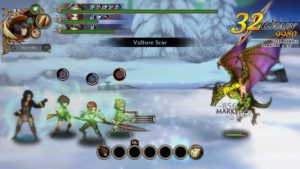
If I’m being entirely honest, what had me excited about this game was the combat. I love a good story, but great gameplay is what makes or breaks a game to me. The combat is incredibly fast paced, utilizing three of the four face buttons to control your three Exemplars and the fourth (in conjunction with either the up arrow, down arrow or no arrow at all) casts spells. Your Exemplars regenerate attacks steadily over time, so you can’t just keep mashing the same attack and using the same Exemplar, but if you play things right you’ll have a nonstop, steady stream of attacks. There’s also a meter at the bottom that has up to 7 circles and each circle can have random modifiers like extra attack power, a free attack or haste to speed the attack up. If you can get to the end of the meter the final attack will do something special like making all your ranged allies attack the rear enemy for a short time, hurting all the enemies or doing multiple attacks. The special attack depends on which ally utilizes that final hit, so there’s a strategy in having the right ally attack at the right time. HOWEVER, if an enemy hits you your meter will reset, but you can parry any enemy attack with a well-timed block, and timing it just right will even reduce the attacker’s defense temporarily.
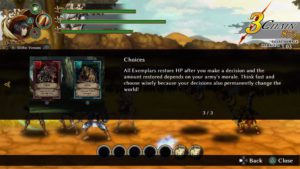
To make things even more interesting you’ll frequently come across choices between combat rounds. You’re given a situation and three options of what to do, and each option gives you an item or a character will get some kind of buff for the area. Like Telltale games these choices are timed, but unfortunately silence is never a valid option and sometimes none of the choices sound too nice. These options do seem to change things in the game as well – choices can cause some of your Exemplars to evolve into a more powerful form. Choices also lead to events in the game, such as unlocking different new areas and getting rewards. Choices sometimes either increase or reduce your overall morale, which somehow ties into the game but I never really saw how. Finally, choices can lead to warnings – at one point I had chosen several options in a row that used funds and I was warned that funds were running low so I had to back off on using them. The game doesn’t show you your food levels, funds or any other resources, and many of the characters discussed in the game aren’t ever properly introduced so it’s increasingly difficult to make informed decisions.
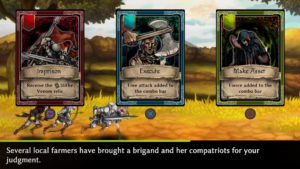
Each area on the map can be one of two things – either an area full of multiple battles or an area that’s only story. You can always replay any of these areas at any given point, and you’re judged at the end of an area on how well you did. Beating a combat area gives you a gem (you can equip 3 and each does something to buff your Exemplars, modify the attack meter and/or change our your main character’s available spells) and a tribute. The game doesn’t have EXP or leveling, instead you collect tributes that grant your Exemplars buffs or allow you to collect items from choices. This means you can theoretically go back and grind to become more powerful, but it’s so RNG-based that it doesn’t feel like you’re consistently working toward a goal. This point is moot, however, as grinding really isn’t necessary.
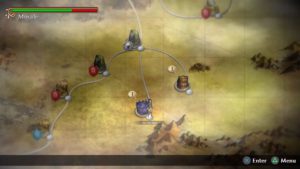
Have you ever played a fighting game that you weren’t very familiar with, so you just mashed the hell out of all the buttons hoping to win by any means necessary? Maybe you just like throwing endless fireballs or playing as someone with really long reach like Dhalsim from Street Fighter 2. That’s how the majority of my time with Fallen Legion: Flames of Rebellion felt. Yes, you can be very strategic, but every time I tried to slow down and use strategy rather than mashing buttons I got annihilated. Despite this button mashing “strategy” the game was tense – you’re bouncing between attack buttons, casting spells to heal, attack and revive when necessary and blocking countless attacks. In fact, between keeping an eye on which Exemplars can attack, when your spells are ready, trying to set up the right Exemplar to use their special attack in the attack meter and looking out for enemy attacks, your eyes are constantly moving all over the place. Add in lots of movement and animations from special attacks and often it’s impossible to see if or when an enemy is attacking anyway. This chaos made the game feel more real, more unpredictable, and more like I was in the heat of a battle than simply giving commands at my own pace.
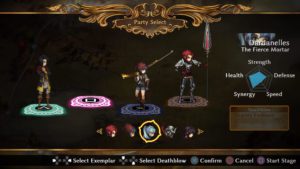
Normally this level of stress and focus would make for a really fun game, but I just never really felt like I was having fun. It just felt like I was going through the motions, playing level after level, learning about the story. I would’ve played the whole game before reviewing it except that I came across a combat level that had a ridiculously long boss battle. I don’t know if I was using the wrong Exemplars or if I was using the wrong combinations or if this particular boss was supposed to take a long time but I’d fought it for at least 15 minutes with no end in sight (the lower his health got the more he would heal himself back up) and I eventually died. There was no way I was attempting that fight again because it was just so monotonous and long unlike secret, ridiculously difficult boss battles in games like Final Fantasy 7 or Kingdom Hearts.
Finally worth mentioning is the sound design. I don’t often play the background music in games as my gal hates repetitive noise, but I almost turned the audio back on for the first several hours because there were SOOOOOO many times (especially during silent conversations) when there were cricket noises in the background. These crickets were fair for filler noise but they drove the two of us insane, so much so I ended up having to mute and unmute the TV until I was out of the areas where the crickets were. You’ll also be hearing the same special attack names yelled out frequently throughout a battle, which can get a bit annoying after a while, but the rest of the battle sounds are epic. You’ll end up creating a chaotic symphony between your various attacks, exclaimed names of special attacks and clanging from successful blocks.

Overall the game certainly wasn’t bad, and while I did enjoy my time a bit, I was let down that it felt more like trying to get through a game than enjoying my time with it. With a great game I keep hoping it never ends, I extend the length of the game as much as possible by doing every side activity possible and pray that there are things to do after the game ends. With Fallen Legion: Flames of Rebellion I just kept hoping each mission would lead to more story or would end the game. I’m still incredibly curious about what happens story-wise, but at this point I’d rather look it up or watch someone else expertly play through it than play it myself. Also, as shown in the screenshot above, it IS pretty fun when you get JUST the right grades after a level…
*Note: I was given a free code of this game in exchange for my honest review*

